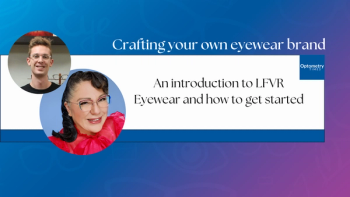
Managing presbyopia with evolving inlay technology
Innovation does not cease and nor should our ability to stay abreast of the latest surgical options for our patients. The ever-growing population of presbyopes is endless, and the desire to rid oneself of spectacles is unquenchable.
Innovation does not cease and nor should our ability to stay abreast of the latest surgical options for our patients. In past departments I have written about evolutionary options our patients have for presbyopia management. The ever-growing population of presbyopes is endless, and the desire to rid oneself of spectacles is unquenchable.
The myriad of options has been detailed in Optometry Times, and those who have sought refractive surgical options in the past are great candidates today. The latest option available is the Raindrop Near Vision Inlay (ReVision Optics). While this inlay is hard to detect in the cornea, management should not be a challenge.
The ideal Raindrop patient is slightly hyperopic with a range of +1.00 D to -0.50 DS, and less than or equal 0.75 DS cylinder. The eye must be healthy, with no previous refractive surgery and normal corneal and anterior segment. Most importantly, the patient must have a disposition that will be conducive to monocular surgery.
Previously from Dr. Bloomenstein:
Pre-operative preparation
Pre-operative management for Raindrop is straight out of the optometric playbook-control the inflammation and allow for a healthy tear film. Patients who have irregular topography, thinner corneas, ectactic disease, or uncontrolled retinal disease are contraindicated for the inlay-dry eye should be controlled and not prohibitive.
In the initial pre-operative phase, emphasize the importance of retaining homeostasis of the tears and the patient’s ability to neuro-adapt to this presbyopic correction. A trial lens with a multifocal contact lens in the non-dominant eye-often left in the eye up to a week-can simulate the near-to-distance adaption.
You should be prepared for the post-operative journey now that your patient is ready for this 2-mm diameter, 30-micron thin inlay. Raindrop has the same water content and refractive index as the cornea.1 Controlling inflammation and continuance of homeostasis is the critical action in the procedure’s success.
Most surgeons will use a regimen of an antibiotic for a week, a steroid such as Durezol (difluprednate, Alcon) for a month, artificial tears frequently, and the addition of a tear medication such as cyclosporine (Restasis, Allergan) or lifitegrast (Xiidra, Shire) in the presence of any keratoconjunctivitis sicca. The steroid is continued for two to three months. The follow-up schedule is left to the doctor’s discretion because outcomes will dictate the importance.
Post-operative expectations
The one-day visit for any procedure should be named the “kiss and cry” visit after the “kiss and cry” booth that ice skaters sit in after a competition. Patients are happy and kissing or they are sad and crying. I take no value in the visual acuity of any surgery on day one and to be happy or sad is not relative.
The vision will be blurred, and often with Raindrop the uncorrected near visual acuity (UCNVA) will be close to 20 cm. Advise the patient to be patient. The edema, tear quality, and settling of the inlay may all contribute to the visual acuity quality.
The one to three-month vision should elicit improvement to uncorrected distance visual acuity and more focused uncorrected near visual acuity. The slit-lamp challenge for the managing doctor is to see that the inlay, which takes some maneuvering of the slit-lamp beam, is centered in the visual acuity.
You must visualize the corneal clarity and assess the tear film structure. A normal inlay may have a thin white circle of cells that surrounds its edge, but these cells are expected. As long as the inlay is clear centrally and asymptomatic with good visual acuity, no treatment is needed.
Related:
Dealing with setbacks
Haze development that is encroaching toward the central aspect of the lens is problematic and needs therapeutic intervention. A ring around the edges is anticipated, but when it progresses inwards steroids are warranted.
I restart lotepradanol (Lotemax, Bausch + Lomb) on any patient with haze on the internal edge of the inlay. This haze may or may not be associated with reduced near tasks, increase in glare or halos, and some decrease in the distant visual acuity.
Another objective measurement is steepening in the central corneal topography or slight wavefront aberrometry changes. The initiation of another two to three months of steroids should retard the inflammatory progression and restore the visual sequelae to normal.
If the inlay is decentered, resulting in poor vision, or the haze is unrelenting with central accumulation, these patients should be referred back to surgery for centration or removal.
Presbyopic correction is not a futuristic proposition-rather it is a present opportunity. Having the acumen to help patients navigate through this process is an OD’s destiny. All inlays are different and require different management.
References
1. ReVision Optics, Inc. Raindrop Near Vision Inlay Professional Use Information. Available at: http://www.revisionoptics.com/wp-content/uploads/2016/09/710-0015-Rev-6-Artwork-FDA-Professional-Information-Brochure-US.pdf. Accessed 8/17/17.
Newsletter
Want more insights like this? Subscribe to Optometry Times and get clinical pearls and practice tips delivered straight to your inbox.


















































.png)


